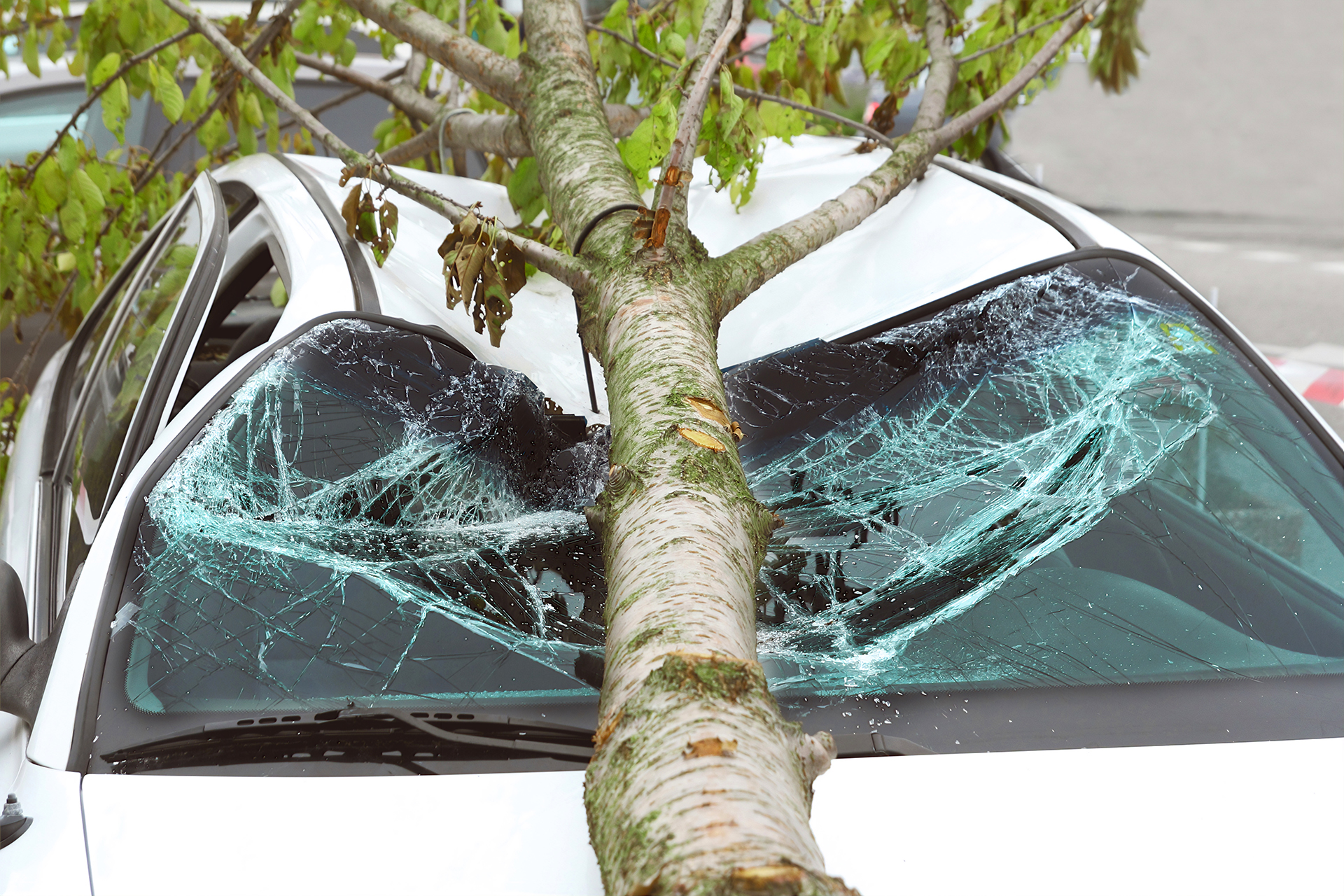Yes No
Share to Facebook
If a Tree Falls Onto a Neighbour's Property and Causes Damage or Injuries, Can the Property Owner Be Held Liable?
Property Owners May Be Liable For Incidents Involving Trees. Where An Owner Failed to Maintain a Tree Despite Knowing That the Tree Posed a Risk the Owner May Be Found Negligent and Liable.
A Helpful Guide For How to Understand the Various Liabilities and Legal Issues That May Arise From Tree Ownership or Maintenance
 Although trees are extensively found throughout our urban and rural landscape, we often take the value of trees for granted. We also often fail to fully appreciate the potential for legal issues to arise from incidents involving tree ownership or tree management. Among other things, legal issues may involve border trees, hazard trees, healthy trees, or nuisance trees.
Although trees are extensively found throughout our urban and rural landscape, we often take the value of trees for granted. We also often fail to fully appreciate the potential for legal issues to arise from incidents involving tree ownership or tree management. Among other things, legal issues may involve border trees, hazard trees, healthy trees, or nuisance trees.
Duty of Care
The basic principles of common law, particularly negligence and the legal test regarding 'duty of care' as founded within the Donoghue v. Stevenson case (a general principles case rather than tree specific case), deem that property owners owe a duty to ensure that other persons and the property of others persons is reasonably safe. In Ontario, these duties are codified the Occupier's Liability Act, R.S.O. 1990, c. O.2, as:
3(1) An occupier of premises owes a duty to take such care as in all the circumstances of the case is reasonable to see that persons entering on the premises, and the property brought on the premises by those persons are reasonably safe while on the premises.
Negligently Performed Maintenance
Owners of trees, or others responsible for trees (such as hired maintenance contractors), generally face liability only when it was known, or constructively known, that a tree failure risk was present and the owner (or others) failed to properly tend to the tree. In this way it can be thought that the injury or damage was a result of delay in caring for the tree rather than the result of risks inherent in a tree. Essentially, the negligent 'failure to maintain' is a man-made risk rather than a natural tree risk. On the point of liability for failure to maintain trees, the Superior Court of Ontario (Divisional Court) said in Hallok v. Toronto Hydro Electric System Ltd., 2003 CanLII 8519 at paragraph 14:
It would appear to be common ground that a property owner, such as Park Lawn, cannot be held responsible for damage resulting from a limb on a tree falling simply on the basis that the limb or tree fell. If the evidence does not establish that there was knowledge on the part of the defendant, Park Lawn, of a dangerous condition of a tree or that there was a dangerous condition of which the defendant Park Lawn ought to have knowledge, a finding of negligence is unavailable as a matter of law. (See: Culley v. Maguire, [1957] O.J. No. 52 (C.A.) at p. 1; Quinlan v. Gates, [2000] O.J. No. 5292(S.C.J.) at p. 2; Buttoni et al. v. Henderson et al., 21 O.R. 309 (H.C.J.) at p. 371; Doucette v. Parent, [1996] O.J. No. 3493 (Gen. Div.) at p. 4; Gasho v. Clinton (Town), [2001] O.J. No. 4505 (S.C.J. (Small Claims) at p. 4).
As such, it seems that knowledge, or constructive knowledge, of a dangerous condition is a requirement of liability for negligent maintenance of trees. Note that "constructive knowledge" is knowledge which the law deems a person ought to have based on reasonableness. If a reasonably diligent person would know of a dangerous condition this is "constructive knowledge" and proving actual knowledge becomes unnecessary. Constructive knowledge is often much easier to prove than actual knowledge. For example, following severe storms, property owners should reasonably be on alert for broken branches (known in arboriculture circles as "hangers") as well as other dangerous conditions. Additionally, it is important to recognize that intentionally avoiding investigation and thereby choosing to remain unaware of a dangerous condition may be deemed an act of willful blindness from which constructive knowledge may also be imposed.
Trees Along Realty Lines, property boundary
Neighbour disputes involving trees often involve debate over ownership, and therefore decision making power, involving trees whose trunk rests upon the property line. A tree upon the property boundary is commonly referred to as a 'border' tree.
As per the Forestry Act, R.S.O. 1990, c. F.26 at section 10(2), a tree upon the property line is jointly owned by each neighbour. This position was reviewed and iterated well within the case of Hartley v. Cunningham, et al, 2013 ONSC 2929. Where a border tree exists, decisions as may affect the border tree generally require a mutual agreement between the neighbouring realty owners. A neighbour that makes decisions without consultation with, and agreement from, a joint owner of a tree may become subjected to litigation seeking compensation for wrongful trespass. Despite the Hartley decision, which generally requires mutual agreement, courts have permitted 'self-help' removal of a border tree for the purpose of abating a nuisance; Freedman v. Cooper, 2015 ONSC 1373; but only in situations where doing so is reasonably necessary; Davis v. Sutton, 2017 ONSC 2277 at paragraph 56 to 64.
In any and all cases involving the destruction and liability of a tree, the valuation of a tree may be highly subjective involving criteria beyond simply 'wood' value - see more below on 'Value of Trees'.
Hazard Trees, including attractive nuisance
The ownership of trees brings legal risks relating to public safety as similar from other realty property ownership risks borne out of the Occupier's Liability Act. Although hazard trees are generally presumed as unhealthy and structurally failing trees, much can be said for serious risks posed by fully healthy trees. The 'healthy hazard' may exist where tree branches or roots intrude upon neighbouring property and cause damage or other interference (see examples below). Children may also find trees as a climbing interest and fall from branches resulting in personal injuries or even suffer electrical shock injuries when the weight of a child causes a branch to contact electrical lines; MacDonald v. Goderich (Town), 1947 CanLII 113. Additionally, fruit trees may attract dangerous insects or animals thereby posing risk.
Cases Involving Trees, nuisance
The legal concept of nuisance involves interference by a person (or persons) with the reasonable enjoyment of property of another person (or persons). The list of ways in which someone can interfere with anothers property is extensive and trees are sometimes are the cause. Trees can cause nuisance by shedding debris; Gallant v. Dugard, 2016 ONSC 7319 (falling walnuts - dismissed), by invading roots; Churchill Investments Ltd. v. Allied Holdings Ltd., 1975 CarswellBC 510 (drainage system damage); Black v. Zager, 1982 CarswellMan 67 (building foundation damage); Yates v. Fedirchuk, 2011 ONSC 5549 (swimming pool damage), or other concerns.
While tree owners should take proper care to reduce or eliminate the risk of nuisance to others, the law of nuisance is generally deemed that strict liability applies; and accordingly, liability for damage caused by an interfering tree can arise regardless of the level of care taken by the tree owner. Furthermore, a neighbour whose property is affected by a nuisance tree may have right to 'self help' so long as no trespass across the property boundary occurs. Common to the efforts to remedy a nuisance is the destruction of invasive roots during construction processes involving excavation; Edwards v. Poldrugo, 2003 BCPC 398; Anderson v. Skender, 1993 CanLII 2772.
While it is more common that the tree poses the nuisance when the tree branches or tree roots intrude upon a neighbours property, sometimes something emanating from a neighbours property results in damage to the tree thereby posing an actionable nuisance claim for the tree owner. A seminally influencing case example involved Schenck, et al v. Ontario, [1987] 2 S.C.R. 289, where the Supreme Court determined that salt drifting from the Q.E.W. highway as a result of winter snow and ice control operations was causing damage to tree orchards and that such a nuisance was essentially an expropriation requiring compensation.
Cases Involving Trees, trespass
Liability for trespass involving trees most commonly occurs when trees are wrongfully cut down. The unintentional trespass can occur innocently by accident or negligence Barnstead v. Ramsey, 1996 CanLII 1574; Sinkewicz v. Schmidt, 1994 CanLII 5148 or as well as occur intentionally such as when a property owner trespasses and cuts a neighbours trees for an ulterior purpose such as improving sightlines; Kates v. Hall, 1991 CanLII 1127; McKim v. Degraaf, 1991 CanLII 399 as well as to facilitate construction projects; Hik v. Kerr, 1992 CanLII 2352.
Generally, when trees are cut during an intentional trespass the liability imposed will be heavier whereas punitive damages may apply; Gibson v F.K. Developments Ltd., 2017 BCSC 2153 Horseshoe Bay Retirement Society v. S.I.F. Development Corp., 1990 CanLII 8047 ($100,000 punitive)
Damages Valuation Difficulty, value of trees
As above, the value of trees may be highly subjective. When someone has damaged or destroyed the tree of another, the tree owner often takes the position that loss of the tree involves much more than the loss of 'wood' but also loss of various benefits previously enjoyed by the presence of the tree. Valuation factors involving trees may include consideration for loss of amenities including shade, privacy, windbreak, and other intangible aspects. In some cases, an award for reduction of realty values is applied; Sinkewicz. In other cases, the costs of restoration of trees is awarded; Barnstead, Horseshoe Bay, and Kates. Generally, when the restoration valuation is applied for actual damages, the tree nursery cost and the installation expense is awarded.
Arborists certified as appraisers by the International Society of Arboriculture or American Society of Consulting Arborists can often provide reasonable tree valuations by using professional standards such as the 'CTLA method' of valuation.
Bylaws
Almost every municipality will enact bylaws that address trees. Many impose permit requirements for residents seeking to remove trees and obtaining a permit for the removal of a tree will require good reason such as where the health of the tree is failing and the tree is becoming a hazard and poses a risk of injury or damage. In these circumstances, a report from an arborist certified by the International Society of Arboriculture is typically required.
It is also common that municipalities will govern the way trees owned by the municipality, being those trees upon municipal lands such as parks or the 'street' trees located along roadways beyond the boundary of private land owners. For example, Bylaw 78-2008 of the City of Oshawa restricts interference with municipal trees and states that such interference may include posting signage upon trees or even the climbing of trees. Contravention of Bylaws may result in prosecution as an offence via processes of the Provincial Offences Act, R.S.O. 1990, c. P.33.
Offences
In addition to potential prosecution for violation of municipal bylaws, other offences may exist and be prosecuted per the Provincial Offences Act, such as where a person "... injures or destroys a tree growing on the boundary between adjoining lands without the consent of the land owners ..." in contravention of the Forestry Act, R.S.O. 1990, c. F.26., s. 10, as did occur in the case of Gross v. Scheuermann, 2017 ONCJ 722 ($5,000 fine).


